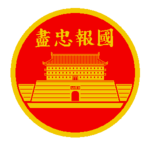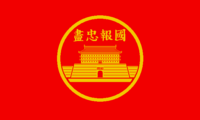Ministry of National Defense (Menghe)
| Dae Meng Sahoejuyi Gonghwaguk Gukbangbu 대멩 사회주의 공화국 국방부 | |
 Official emblem | |
 Parade flag | |
 Headquarters building | |
| Ministry overview | |
|---|---|
| Formed | April 4, 1964 |
| Jurisdiction | Menghe |
| Headquarters | 27 Haebang-ro, Gosŏng-gu, Donggyŏng |
| Motto | Serve the Country with Utmost Loyalty |
| Annual budget | ₩7.728 trillion ($345 billion) (2017) |
| Minister responsible |
|
| Ministry executives |
|
| Child agencies |
|
The Ministry of National Defense (Menghean: 국방부 / 國防部, Gukbangbu), often abbreviated MoND in Anglian-language literature, is the cabinet-level agency tasked with overseeing and managing the Menghean Armed Forces.
The Minister of National Defense, currently Kim Jŏng-min, is appointed by the Chairman of the Supreme Council of Menghe, currently Choe Sŭng-min. Choe concurrently holds the post of Supreme Commander of the Menghean Armed Forces, which serves mainly to clarify his position as commander-in-chief. By convention, the Minister of National Defense also sits on the Central Steering Committee of the Supreme Council of Menghe, giving him a key role in critical decisions within the civilian government.
History
Menghe's first modern, Western-style cabinet was assembled under the Federative Republic of Menghe, the unified government established in 1900. Like many other countries at the time, the Federal Republic of Menghe had a Ministry of War, which dealt specifically with the Army, and a Ministry of the Navy, which dealt with naval affairs.
Division between ministries intensified Army-Navy interservice rivalry, a problem which continued after the formation of the Greater Menghean Empire in 1927. Redundant procurement systems created inefficiencies in design and production, and disagreement over national strategic goals led to disorganized planning before and during the Pan-Septentrion War.
When the Democratic People's Republic of Menghe organized its new cabinet in 1964, its leaders deliberately chose a unified Ministry of Defense, in the hopes that this would rein in interservice rivalry and streamline procurement. The Menghean People's Communist Party also saw the Ministry of Defense, a civilian government body, as a tool for maintaining limited control over the Army and Navy, which were staffed by Nationalist personnel and had been guaranteed some autonomy under the Sangwŏn Agreement.
Following the Decembrist Revolution and the establishment of the Socialist Republic of Menghe, the Ministry of Defense has been exclusively referred to as the Ministry of National Defense in official Anglian-language literature, even though its Menghean-language form has not changed. Its organization also remains largely the same, with the Army and Navy subordinate to its unified command, and liaison offices to the MPCP replaced by liaison offices to the MSP.
Civilian-military ties
While in many other countries the Ministry of Defense serves to subordinate the armed forces to a civilian authority, in Menghe this is not necessarily the case. In the Federative Republic of Menghe and the Greater Menghean Empire, the Ministries of War and Navy served as leadership offices for their respective branches, and were headed by a high-ranking officer appointed at the request of the branch in question. The DPRM likewise did not exert direct authority over the Army and Navy in administrative affairs, giving both organizations limited autonomy and serving mainly as a common route for procurement and funding.
The boundary between state and military power has become even more blurred under the leadership of Choe Sŭng-min, who came to power in a military coup and temporarily ruled the country through a military junta. During the interim period, Choe granted himself the rank of Supreme Marshal, and created the post of Supreme Commander of the Armed Forces, which he holds concurrently with Chairman of the Supreme Council and General-Secretary of the Menghean Socialist Party. Thus, his power as commander-in-chief stems not from his civilian role but from his dual role as the highest-ranking officer in both branches. A Major-General before his rise to power, Choe regularly wears a military uniform, and could just as plausibly be classified as a military official administering a civilian government.
Since 1988, all Ministers of National Defense have held a General- or Admiral-grade post in the Army or Navy prior to appointment, and all have had their rank increased to Marshal upon or prior to appointment. Appointment decisions are made by the Chairman of the Supreme Council, but back-room recommendations by Army and Navy officials may drive the selection of candidates. Because the Minister of Defense sits on the Steering Committee of the Supreme Council, this arrangement effectively gives the military a say in any top-level decisions with implications for national security.
MoND Troops
The MoND Troops (Menghean: 국방부 부대 / 國防部部隊, Gukbangbu Budae) are a subset of the Menghean Armed Forces which report directly to the Ministry of National Defense rather than the Army or Navy. These forces are not considered co-equal to the other branches, and are commanded by four-star rather than Marshal ranks. They are formally classified as Agency-level bodies, but are run by a mix of civilian staff and active military personnel.
Over time, the number of assets directly managed by the MoND has increased, reflecting an effort to improve cooperation between the Army and Navy. The Strategic Communications Agency, for example, manages all communications satellites and land-based communications hubs, and the Strategic Logistics Agency can move shared ammunition and missile cargo from central stores to Army or Navy bases. Many new strategic organizations, such as the Cybersecurity Research and Operations Agency, were also placed directly under the MoND. In recent years, some Directorate and General-Directorate level bodies have also been upgraded to independent Agencies, reflecting a greater emphasis on these operational areas.
Structure
The lead executive body in the Ministry of National Defense is the National Defense Council, which is made up of the highest-ranking officers in the Army, Navy, and other MoND bodies. The National Defense Council also doubles as the general staff of the Menghean Armed Forces. The Chief of the General Staff manages its regular operation, while the Minister of Defense serves as its liaison with the civilian government, and the Supreme Commander of the Armed Forces weighs in on administrative and high-level strategic decisions.
As of 2017, the administrative structure of the Ministry of National Defense is divided into two Armed Services, six Agencies, at least nine General-Directorates, and at least eleven Directorates. The Strategic Logistics Agency was upgraded from a General-Directorate level body in 2012, the Cybersecurity Research and Operations Agency was split off from the EIA in 2017, and the Military Publicity Agency was upgraded from a Directorate-level body in 2019. Other administrative bodies may also exist.
Central leadership:
- Minister of Defense
- National Defense Council - General Staff of the Menghean Armed Forces
Armed services:
- Administrative Office of the Menghean Army
- Administrative Office of the Menghean Navy
Agency-level bodies:
- External Intelligence Agency
- Cybersecurity Research and Operations Agency
- Military Discipline Inspection Agency
- National Defense Advisory Agency
- Military Publicity Agency
- Strategic Communications Agency
- Strategic Logistics Agency
General-Directorate-level bodies
- General-Directorate for Procurement
- General-Directorate for Research and Development
- General-Directorate for Doctrinal Development
- General-Directorate for Servicemen Training
- General-Directorate for Political-Military Relations
- General-Directorate for Ex-Servicemen Welfare
- General-Directorate for Military Medicine
- General-Directorate for Fixed-Wing Aviation
- General-Directorate for Officer Training
Directorate-level bodies
- Social Consultation Directorate
- Finance and Budgeting Directorate
- Military Records and Archives Directorate
- Military History Research Directorate
- Aviation Safety Directorate
- Nuclear Facilities Security Directorate
- Staff Transportation Directorate
- Housekeeping and Hospitality Directorate
- Military-Owned Lands Management Directorate
- Information Directorate
- Armed Forces Entertainment Directorate
- Legal Directorate
Among the MoND's key bodies are the General-Directorate for Procurement and the General-Directorate for Research and Development. These bodies were added in 1964 to impose a common procurement and development policy. While the Army and Navy operated redundant weapons, aircraft, and heavy guns during the Pan-Septentrion War, for example, Menghe's postwar aircraft carriers have all used navalized derivatives of land-based fighters - the DS-5 and DS-9, respectively. The General-Directorate for Procurement is responsible for managing the procurement budget and setting design requirements for new equipment, and the General-Directorate for Research and Development operates its own in-house facilities for testing, though most actual design work is done by various state-owned corporations.
The Ministry of National Defense also administers the External Intelligence Agency, which is concerned with intelligence-gathering and active operations "in relation to military security" - that is, predominantly in foreign countries. Its domestic counterpart, the Internal Intelligence Agency, is subordinate to the Ministry of Internal Security, and is mainly concerned with counter-espionage, censorship, and the arrest and interrogation of high-level dissidents. Though once clearly divided at Menghe's borders, the IIA and EIA have recently clashed over cross-border tasks, such as domestic counter-terrorism and the suppression of dissidents in allied countries.
Headquarters
The headquarters building of the Ministry of National Defense is located at 27 Haebang-ro in central Donggyŏng. This complex, composed of a central three-wing building and a collection of surrounding facilities added later, contains the MoND's upper offices and central administrative functions. The MoND also has top-level personnel based in the Central Military Office of the Donggwangsan administrative complex, which serves as a meeting site for strategic planning and crisis management; the Minister of Defense and Chief of the General Staff are both believe to work from this site.
All of the MoND's Agency-level bodies, and some of its General-Directorate level bodies, have their own branch office buildings. Most are located in Donggyŏng, though a few Army-related bodies are situated in the nearby city of Dongrŭng, which hosts the Army's headquarters building. The Space and Counter-Space Warfare Agency, established in 2018, is headquartered in Insŏng, though it is believed to have a liaison office in the MoND headquarters itself.
Emblem
The emblem of the Ministry of National Defense contains the Yŏnghwa Gate of the city of Dongchŏn, a site of major symbolic importance in Menghean nationalism. During the Uzeri Rebellion, when Tyrannian Royal Marines assaulted the city of Dongchŏn, the towering and recently refurbished Yŏnghwa Gate withstood repeated attacks, including attacks from land-based and sea-based cannons, in a show of resistance not matched anywhere else in the war. The garrison surrendered only after Tyrannian forces broke through the Pyŏnghwa Gate on the west side of the city and began firing on the gate from both sides; the commander, Wu Man-sŏk, committed suicide rather than face his attackers.
Above the gate are the Gomun characters 盡忠報國 (Jinchung Buguk), which can be translated as "Serve the Country with Utmost Loyalty" or "Loyally ask what you can do for the Country." This phrase surfaces several times in Menghean history and writing, most famously when General Ak Bi of the Sung Dynasty has the four characters tattooed on his back to signal his determination to repel a nomadic incursion. The phrase also gained popularity in military circles during the Menghean War of Liberation, and appeared on the banner of the Eighth Army, a guerilla unit composed of soldiers who had refused to surrender in 1945.
The flag of the Ministry of National Defense features the same emblem on a red background. Distinct from the flag of the Menghean Army and the flag of the Menghean Armed Forces, it is flown outside the MoND headquarters building and carried at military parades.